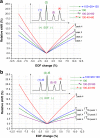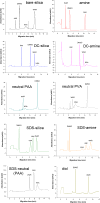Improving repeatability of capillary electrophoresis-a critical comparison of ten different capillary inner surfaces and three criteria of peak identification
- PMID: 28484810
- PMCID: PMC5486911
- DOI: 10.1007/s00216-017-0382-y
Improving repeatability of capillary electrophoresis-a critical comparison of ten different capillary inner surfaces and three criteria of peak identification
Abstract
A poor repeatability of migration times caused by the fluctuations of electroosmotic flow (EOF) is an inherent weakness of capillary electrophoresis. Most researchers endeavor to prevent this problem using relative migration times or various capillary coatings which are expensive and not easy in comparison. Herein, we present an original approach to this problem: we apply a model sample designed to induce significant EOF instability, in order to critically compare ten capillary types with different physicochemical characteristics. Moreover, we accompany capillary modification with the evaluation of various criteria of peak identification: migration time, migration times ratio, and electrophoretic mobility. Our results show a great effectiveness of a dynamic coating in the stabilization of migration times, with the average RSD(%) value reduced from 3.5% (bare silica capillary) down to 0.5%. The good outcomes were also obtained for the surfactant-modified silica and amine capillaries. For the capillaries exhibiting significant instability of EOF, electrophoretic mobility turned out to be a more universal and reliable criterion of peak identification than relative migration time. It can be explained by an intrinsic dependency of migration times ratio on EOF change, which should always be considered during the selection of an internal standard.
Keywords: Capillary coating; Capillary electrophoresis; Electrophoretic mobility; Micellar electrokinetic chromatography; Relative migration times; Repeatability.
Conflict of interest statement
The authors declare that they have no competing interests.
Figures




Similar articles
-
Capillary electrophoresis using core-based hyperbranched polyethyleneimine (CHPEI) static-coated capillaries.J Sep Sci. 2009 Oct;32(20):3489-96. doi: 10.1002/jssc.200900332. J Sep Sci. 2009. PMID: 19750504
-
Measuring electroosmotic flow in microchips and capillaries.Methods Mol Biol. 2006;339:187-202. doi: 10.1385/1-59745-076-6:187. Methods Mol Biol. 2006. PMID: 16790874
-
Suppression of electroosmotic flow and its application to determination of electrophoretic mobilities in a poly(vinylpyrrolidone)-coated capillary.J Chromatogr A. 2006 Feb 17;1106(1-2):52-5. doi: 10.1016/j.chroma.2005.08.062. Epub 2005 Sep 8. J Chromatogr A. 2006. PMID: 16443452
-
Capillaries modified by noncovalent anionic polymer adsorption for capillary zone electrophoresis, micellar electrokinetic capillary chromatography and capillary electrophoresis mass spectrometry.Electrophoresis. 2001 Aug;22(12):2565-73. doi: 10.1002/1522-2683(200107)22:12<2565::AID-ELPS2565>3.0.CO;2-I. Electrophoresis. 2001. PMID: 11519960
-
[Improvement of reproducibility in capillary electrophoretic characterization of rhubarb by normalization of migration time].Se Pu. 2009 Jul;27(4):489-93. Se Pu. 2009. PMID: 19938510 Chinese.
Cited by
-
SLIM Ultrahigh Resolution Ion Mobility Spectrometry Separations of Isotopologues and Isotopomers Reveal Mobility Shifts due to Mass Distribution Changes.Anal Chem. 2019 Sep 17;91(18):11952-11962. doi: 10.1021/acs.analchem.9b02808. Epub 2019 Sep 6. Anal Chem. 2019. PMID: 31450886 Free PMC article.
-
A Software Tool for Rapid and Automated Preprocessing of Large-Scale Serum Metabolomic Data by Multisegment Injection-Capillary Electrophoresis-Mass Spectrometry.Anal Chem. 2025 Jan 14;97(1):175-184. doi: 10.1021/acs.analchem.4c03513. Epub 2024 Dec 27. Anal Chem. 2025. PMID: 39729551 Free PMC article.
-
Examining the Effects of Netropsin on the Curvature of DNA A-Tracts Using Electrophoresis.Molecules. 2021 Sep 28;26(19):5871. doi: 10.3390/molecules26195871. Molecules. 2021. PMID: 34641414 Free PMC article.
-
Capillary Electrophoresis-Mass Spectrometry at Trial by Metabo-Ring: Effective Electrophoretic Mobility for Reproducible and Robust Compound Annotation.Anal Chem. 2020 Oct 20;92(20):14103-14112. doi: 10.1021/acs.analchem.0c03129. Epub 2020 Oct 1. Anal Chem. 2020. PMID: 32961048 Free PMC article. Clinical Trial.
-
[Progress of highly reproducible capillary electrophoresis].Se Pu. 2024 Jun;42(6):544-554. doi: 10.3724/SP.J.1123.2023.12004. Se Pu. 2024. PMID: 38845515 Free PMC article. Chinese.
References
-
- Ali I, Aboul-Enein HY, Gupta VK. Precision in capillary electrophoresis. Anal Lett. 2006;39:2345–2357. doi: 10.1080/00032710600755850. - DOI
LinkOut - more resources
Full Text Sources
Other Literature Sources

